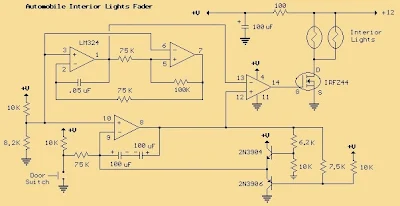Interior Light Fader for Cars Using LM324 – Soft Lighting with a Vintage Touch
Modern cars come with soft glowing interior lights that gently fade in and out when you open or close a door. Want to bring that same sleek effect to an older vehicle? This DIY project is for you! Using the low-power LM324 operational amplifier, you can build a smooth interior light fader circuit that adds a professional touch without draining your car battery.
How the Circuit Works
The heart of this project is the LM324, a quad op-amp IC that draws only about 3mA, making it ideal for always-on automotive applications.
1. Triangle Wave Generator (700 Hz)
The first two op-amps in the LM324 (pins 1,2,3 and 5,6,7) are wired to create a 700 Hz triangle wave oscillator. This waveform acts like a reference signal that contributes to pulse width modulation (PWM) later in the circuit.
2. Ramp Generator (5 seconds)
The third op-amp (pins 8,9,10) generates a slow linear ramp — either increasing or decreasing over 5 seconds — depending on whether the door switch is open or closed. This creates the fading effect.
The ramp signal goes up when the door opens (light fading in), and down when the door closes (light fading out). Want it faster or slower? Just change the 75k resistor connected to the door switch. A higher value increases the fade time, while a smaller one makes it quicker.
3. Comparators and PWM Output
The final op-amp (pins 12,13,14) compares the 700 Hz triangle wave with the ramp signal to produce a PWM square wave with a variable duty cycle. This signal then controls a MOSFET (IRFZ44), which adjusts the brightness of the interior lamp smoothly.
4. Voltage Limiting with Transistors
Two small transistors and a few resistors limit the ramp voltage range just slightly above and below the triangle waveform, ensuring a clean transition and avoiding saturation.
Why This Design is Clever
-
🧠 Low Power: The LM324 only draws around 3mA. That means you can leave this circuit running for days without worrying about battery drain.
-
🔧 Simple Build: No need for microcontrollers — just classic analog components.
-
💡 Customizable: Adjust fade time easily with one resistor.
-
🚗 Vintage Friendly: Ideal for retrofitting older cars that lack modern light fade systems.
Applications and Use Cases
-
Upgrading vintage car interiors
-
Camper van ambient lighting
-
Soft cabin lights for DIY vehicles
-
Learning analog circuit design using op-amps
Final Thoughts
With just a handful of components — the LM324, a couple of transistors, a MOSFET IRFZ44, and a few resistors and capacitors — you can bring your car's interior lighting into the modern age. Whether you're restoring a classic vehicle or adding finesse to a DIY build, this fader circuit offers both elegance and simplicity.
Give your car the smooth glow it deserves — fade in, fade out, and cruise in style.
#CarElectronics #LightFader #LM324 #MOSFETDimmer #InteriorLightCircuit #DIYCarMods #OpAmpProjects #ElectronicsForCars















